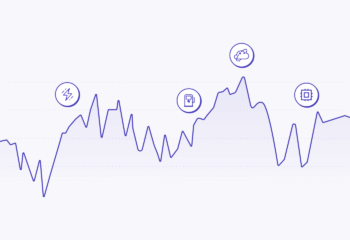Investing can feel complicated—it’s easy to go overboard reading market commentary, chasing stock tips, and listening to what your friends and family members are doing with their portfolios. But Wealthfront has always believed that the stress associated with investing is optional. We automate award-winning research (like Modern Portfolio Theory, which won a Nobel Prize in 1990) and time-tested strategies to make smart investing feel effortless.
But what does that look like in practice? If we had to boil our philosophy down to one sentence, it would be this: We think investors should take a passive approach to long-term investing and focus on what they can control: fees, taxes, and risk.
In this post, I’ll break down exactly what that means.
Why we believe in passive investing
When you hear people talking about picking stocks, shifting their portfolio allocation in response to market conditions, or day trading, they’re generally describing what’s known as active investing. Active investing is, as the name suggests, when you actively choose specific investments at specific times with the goal of outperforming the broader market. Active investing might sound fun (and we think it’s fine to allocate up to 10% of your portfolio to stock picking), but its track record isn’t all that great when you compare it to the alternative.
According to the 2024 year-end SPIVA report, which evaluates the performance of actively managed funds, 78.65% of all domestic funds underperformed their benchmarks in 2024. That number rises to a staggering 94.11% when you look at the last 20 years. What does that mean for you? A large majority of professional active fund managers are underperforming their benchmarks, which means your odds are probably even worse.
That’s why we think you should take a passive approach instead. With passive investing, you don’t spend time trying to beat the market. Instead, you buy investments (often index funds) with the goal of tracking the overall performance of the market.
The importance of keeping fees low
Fees can eat away at your return. While a traditional advisor is likely to charge something like 1% of your portfolio value each year to manage it for you, Wealthfront charges 0.25% or less for our investing products (depending on which specific product you use). That difference might sound relatively small, but over time it can really add up.
Here’s an example to help illustrate the effect that fees can have on a portfolio over time: If you made a one-time investment of $50,000, stayed invested for 10 years, and earned a 7% annual rate of return, your ending balance would be $96,083.53 with a 0.25% annual advisory fee, but just $89,542.39 with a 1% annual fee—a difference of over $6,000. And the bigger your account balance and the longer your time horizon, the larger that difference becomes. Using the same assumptions from the example above, after 30 years, your balance would be $354,818.75 with a 0.25% fee, but just $287,174.53 with a 1% fee—a difference of over $67,000.
We also think it’s important to keep an eye on ETF management fees known as the “expense ratio.” This is the annual fee charged by the ETF’s issuers to manage and operate the fund, and it’s expressed as a percentage of the ETF’s assets. At Wealthfront, when we select ETFs for your portfolio, we focus on keeping those costs low, too. It all adds up.
The importance of minimizing taxes
Taxes aren’t inherently a bad thing—they’re usually a sign you’re making money. But you can still take reasonable steps to lower what you owe so you can keep more of what you earn. At Wealthfront, we use software to automate tax-optimization strategies designed to lower your tax bill at no additional cost and for no additional effort.
Arguably the most powerful way we help minimize your taxes is through our Tax-Loss Harvesting service, which is available in all of our taxable Automated Investing Accounts. Wealthfront’s Tax-Loss Harvesting software monitors your portfolio daily for opportunities to sell investments that have declined below their purchase price, “harvest” the loss, and then replace it with a similar investment so your portfolio’s risk and return characteristics stay roughly the same. At tax time, you can then use those harvested losses to offset any capital gains and up to $3,000 of ordinary income if you have losses left over after that.
Our Chief Investment Officer Burt Malkiel wrote in a previous post that tax-loss harvesting represents “what we consider to be the only reliable way for investors to outperform the market, as it allows you to do so on an after-tax basis.” (For more information about the research supporting our approach to tax-loss harvesting, you can read our white paper.) Through the end of 2024, we estimate that nearly 96% of participating clients who have used our Tax-Loss Harvesting for at least a year have received estimated tax benefit that exceeds fees paid to Wealthfront. On average, that tax benefit has represented a significant multiple of our 0.25% fee—put simply, the vast majority of our clients come out ahead on fees because of Tax-Loss Harvesting alone.
The importance of managing risk
Risk can feel like a bad thing, but in investing, that’s not necessarily the case. The presence of risk is why you can generally get higher expected returns from investing than you can from holding cash. In other words, if you want higher returns, you have to take some risk.
But not all risk is the same. It’s important to take on what’s known as compensated risk (risk that results in higher expected returns) but limit uncompensated risk (which can add volatility to your portfolio but doesn’t necessarily result in higher expected returns). A good way to do this is through diversification. Diversification is the practice of buying a variety of different, relatively uncorrelated investments with the goal of balancing both risk and reward in your portfolio. The idea is that when something happens in the news or the market, not all of your investments will respond to that event in quite the same way, and to some extent, you’ll be better insulated from market volatility as a result.
At Wealthfront, we help investors manage risk in a variety of ways. Our portfolios are well diversified: Automated Bond Portfolios hold ETFs from many issuers with a range of maturities; Wealthfront S&P 500 Direct invests in stocks in the S&P 500® index, which covers roughly 80% of the US stock market; and our Automated Investing Accounts include a globally diversified mix of both stocks and bonds. We also automatically rebalance these portfolios over time so your asset allocation doesn’t “drift” to become either too risky or not risky enough for your specific risk tolerance. If you have a well diversified portfolio and you rebalance it over time, you’ll be in a better position to increase your risk-adjusted returns over the long run.
Build long-term wealth on your own terms
Ultimately, our goal is to help you build wealth on your own terms. That’s why our philosophy is to help you focus on what you can control, and to avoid the temptation to chase investing fads or engage in market timing (like changing your portfolio based on short-term market movements). We hope that by building products that automate these best practices, we can make it even easier to meet your long-term financial goals with confidence.
Disclosure
The information contained in this blog is provided for general informational purposes only, and should not be construed as investment or tax advice. Nothing in this communication should be construed as a solicitation, offer or recommendation to buy or sell any security. Any links provided to other server sites are offered as a matter of convenience and are not intended to imply that Wealthfront Advisers, Wealthfront Brokerage or any affiliate endorses, sponsors, promotes and/or is affiliated with the owners of or participants in those sites, or endorses any information contained on those sites, unless expressly stated otherwise.
Diversification and automated investing do not guarantee profit or ensure against loss. Investor experiences can vary widely based on strategies and time horizons. The process of rebalancing may result in tax consequences. Index funds and ETFs generally offer broad diversification, but may still expose investors to specific market, sector, or asset class risks. Wealthfront provides investment management services but may not achieve returns comparable to those of the general market or specific benchmarks.
The effectiveness of the tax-loss harvesting strategy to reduce the tax liability of the client will depend on the client’s entire tax and investment profile, including purchases and dispositions in a client’s (or client’s spouse’s) accounts outside of Wealthfront Advisers and type of investments (e.g., taxable or nontaxable) or holding period (e.g., short- term or long-term).
Tax-loss harvesting involves certain risks, including, among others, the risk that the new investment could have higher costs than the original investment and the strategy could introduce portfolio tracking error into your account. Tracking error is a measure of financial performance that determines the difference between the return fluctuations of an investment portfolio and the return fluctuations of a chosen benchmark. There may also be unintended tax implications.
Wealthfront Advisers’ investment strategies, including portfolio rebalancing and tax loss harvesting, can lead to high levels of trading. High levels of trading could result in (a) bid-ask spread expense; (b) trade executions that may occur at prices beyond the bid ask spread (if quantity demanded exceeds quantity available at the bid or ask); (c) trading that may adversely move prices, such that subsequent transactions occur at worse prices; (d) trading that may disqualify some dividends from qualified dividend treatment; (e) unfulfilled orders or portfolio drift, in the event that markets are disorderly or trading halts altogether; and (f) unforeseen trading errors. The performance of the new securities purchased through the tax-loss harvesting service may be better or worse than the performance of the securities that are sold for tax-loss harvesting purposes.
Tax loss harvesting may generate a higher number of trades due to attempts to capture losses. There is a chance that trading attributed to tax loss harvesting may create capital gains and wash sales and could be subject to higher transaction costs and market impacts. In addition, tax loss harvesting strategies may produce losses, which may not be offset by sufficient gains in the account and may be limited to a $3,000 deduction against income. The utilization of losses harvested through the strategy will depend upon the recognition of capital gains in the same or a future tax period, and in addition may be subject to limitations under applicable tax laws, e.g., if there are insufficient realized gains in the tax period, the use of harvested losses may be limited to a $3,000 deduction against income and distributions. Losses harvested through the strategy that are not utilized in the tax period when recognized (e.g., because of insufficient capital gains and/or significant capital loss carryforwards), generally may be carried forward to offset future capital gains, if any.
Wealthfront Advisers and its affiliates do not provide legal or tax advice and do not assume any liability for the tax consequences of any client transaction. Clients should consult with their personal tax advisors regarding the tax consequences of investing with Wealthfront Advisers and engaging in these tax strategies, based on their particular circumstances. Clients and their personal tax advisors are responsible for how the transactions conducted in an account are reported to the IRS or any other taxing authority on the investor’s personal tax returns. Wealthfront Advisers assumes no responsibility for the tax consequences to any investor of any transaction.
The mention of “Award-winning research” refers to Modern Portfolio Theory (“MPT”), which is one of the most widely accepted frameworks for managing diversified portfolios. The economists who developed MPT, Harry Markowitz and William Sharpe, received the Nobel Prize in Economics in 1990 for their groundbreaking research.
96% of clients’ TLH benefits vs fees paid estimation: We used each client’s inferred tax rate to estimate their benefit from Tax-Loss Harvesting and compare that benefit to the actual amount they paid in advisory fees, the result is that for nearly 96% of participating clients who have used Tax-Loss Harvesting for at least a year, the estimated tax benefit exceeds fees paid. On average, clients’ tax benefit has been 7.6x our 0.25% annual advisory fee over the life of the account.
Investment management and advisory services are provided by Wealthfront Advisers LLC (“Wealthfront Advisers”), an SEC-registered investment adviser, and brokerage related products, including the Cash Account, are provided by Wealthfront Brokerage LLC (“Wealthfront Brokerage”), a Member of FINRA/SIPC.
All investing involves risk, including the possible loss of money you invest, and past performance does not guarantee future performance. Please see our Full Disclosure for further information.
Copyright 2025 Wealthfront Corporation. All rights reserved.
About the author(s)
Alex Michalka, Ph.D, has led Wealthfront’s investment research team since 2019. Prior to Wealthfront, Alex held quantitative research positions at AQR Capital Management and The Climate Corporation. Alex holds a B.A. in Applied Mathematics from the University of California, Berkeley, and a Ph.D. in Operations Research from Columbia University. View all posts by Alex Michalka, Ph.D



